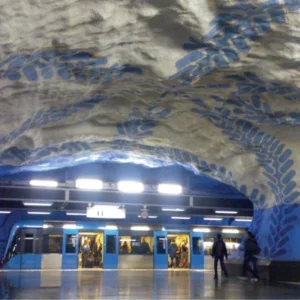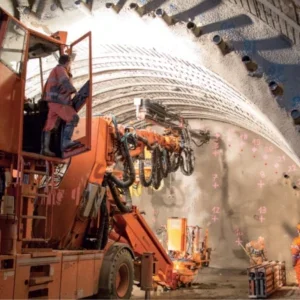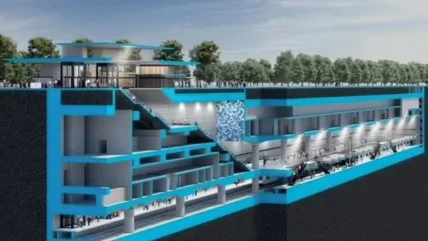
At various stages of development, key tunnel projects across North America are advancing, such as: HRBT’s turnaround of a TBM for a second drive, in Virginia; groundbreaking plus funding for BART, in California; funding, too, for Hudson River Tunnel; and, bids are called from a shortlist on the next Eglinton metro extension package, in Toronto.
US
Virginia: HRBT Project
With two parallel subsea road tubes to bore using a single large diameter TBM, the tunnelling journey on the Hampton Roads Bridge-Tunnel (HRBT) Expansion Project, in Virginia, was always going to be an interesting drive out – and then back.
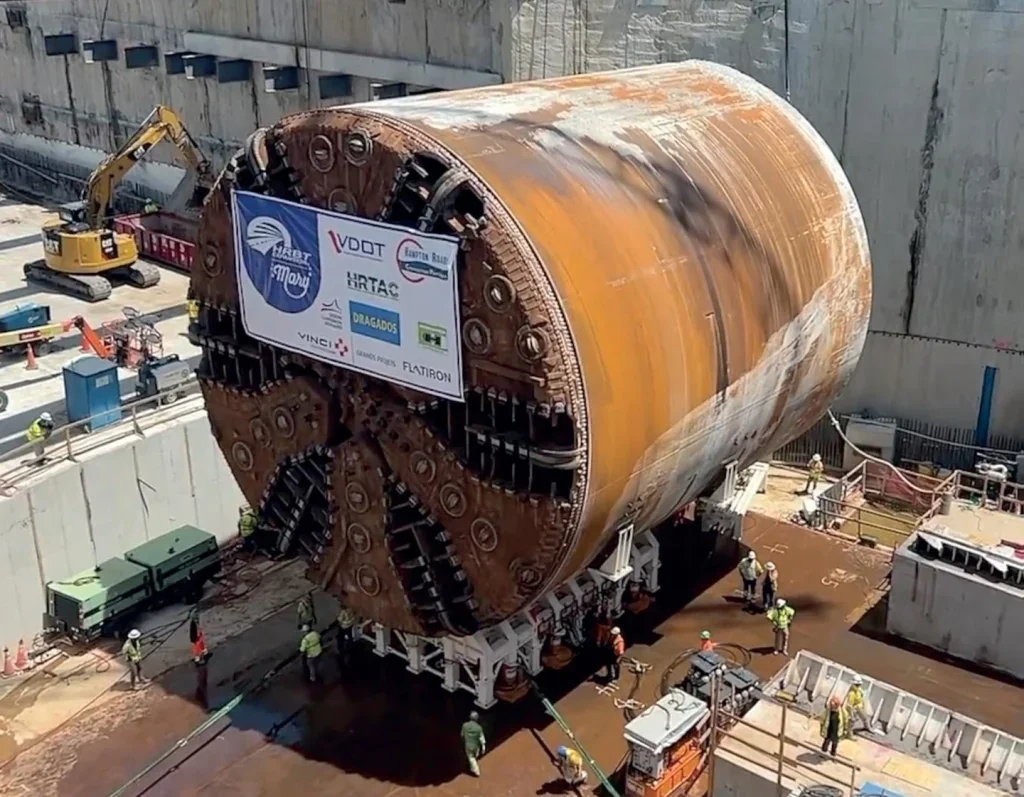
Earlier this year, the 46ft (14m)-diameter variable density TBM achieved breakthrough to complete the first of the two bores through soft soils, taking around a year to complete the 1.5 miles (2.4km)-long tube. Launched from South Island (Norfolk side), the machine – ‘Mary’ – reached the reception pit at the other end of the tunnel, on the North Island, where a whole further challenge awaited.
The heavy TBM had to be turned – to make a U-turn in the open air pit – and be prepared for relaunch and the journey back to its starting point.
No small added complication for the tunnellers as they work on Virginia’s first bored road tunnel. All other tunnels in Hampton Roads are immersed tubes. The TBM U-turn would take up to six months, allowing for relaunch of the machine toward the end of the year and the process has gone well.
Nitrogen skates were used to turn the TBM around – the first time the method has been used in the US. It took eight hours. After that delicate task the shield’s gantries could then be removed from behind, in the bored tube. Buoyancy measures were installed in the tunnel to prevent lifting. Then the work began to reposition the gantries in the long reception and return pit for them to once again line up and form the backup train.
The same technology was used previously in the UK, on London’s twin-tube Silvertown road tunnel project.
The US$3.9bn HRBT Expansion is Virginia’s largest ever highway construction project, calling for the bored tunnel as well as widening an almost 10 miles (16km)-long section of the I-64 corridor in Norfolk and Hampton.
US: BART Project
A groundbreaking ceremony officially launched construction on the BART Silicon Valley Phase II (BSVII) extension, which is the largest transport infrastructure project in the history of Santa Clara County.
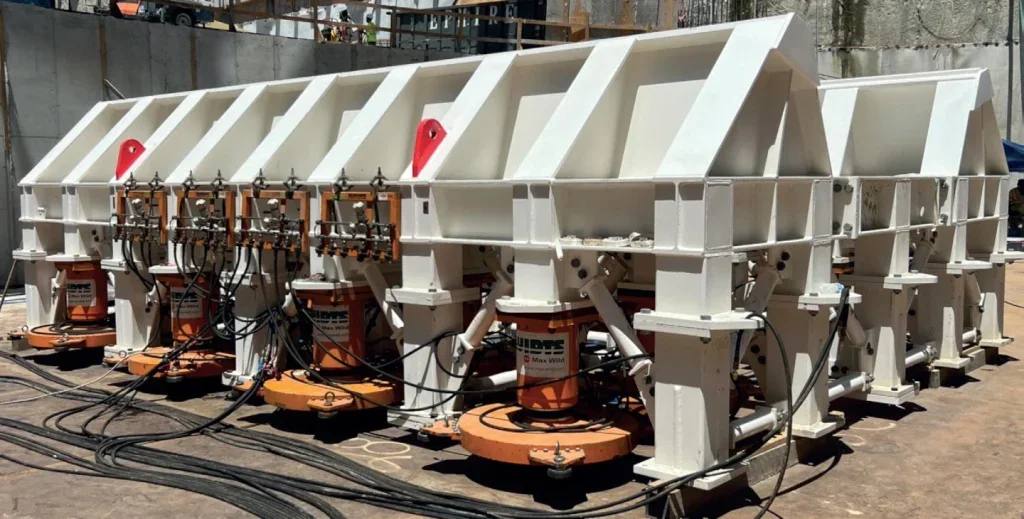
Santa Clara Valley Transportation Authority (VTA) held the event at the future Santa Clara Station and Newhall Yard & Maintenance Facility, in San José and Santa Clara, CA. This is the site of the West Portal, from where a 16.5m-diameter Herrenknecht TBM will be launched to build the 8km-long tunnel from Santa Clara and through downtown San José.
In 2022, Kiewit Shea Traylor joint venture (KSTJV) was awarded the design-build contract for the tunnel and trackwork. The ceremony site will also include building a casting factory for the tunnel’s concrete segmental lining, and also a grout plant and much storage bins.
Recently, VTA awarded Bechtel a 10-year contract for construction management services to the project, which has a total length of 9.6km and includes four stations.
VTA also recently said the Federal Transit Authority (FTA) has committed US$5.1 billion, bringing the funding secured to the US$12.7 billion required for the project.
US: Hudson Tunnel Project
For the Hudson Tunnel Project, the Gateway Development Commission (GDC) recently executed the US$3.8bn Federal-State Partnership (FSP) Grant agreement with the Federal Railroad Administration (FRA), completing the US$12bn federal contribution. The action triggered giving an initial sum of US$1.9bn.
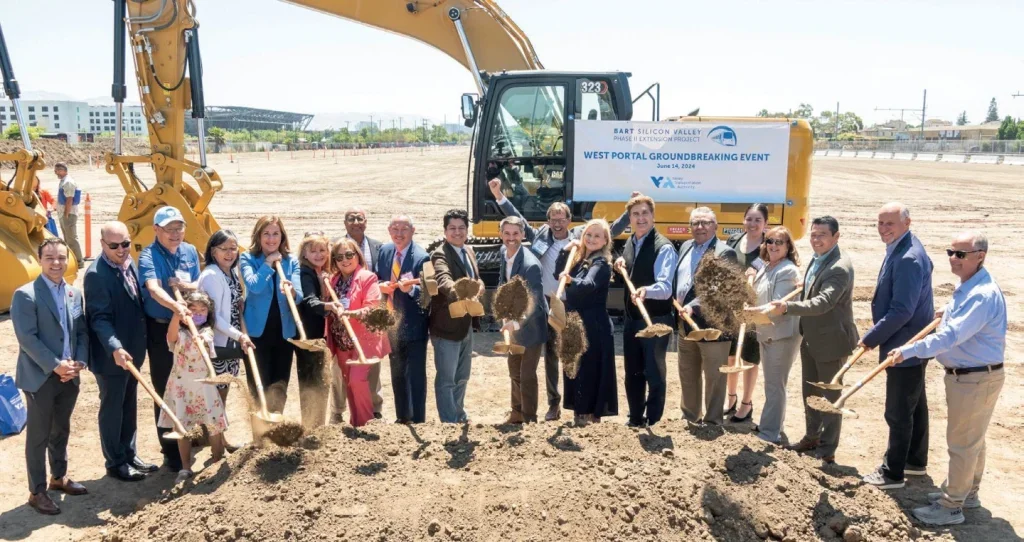
Together with the $US800m in New Starts Capital Investment Grant Programme funding that has already been obligated, GDC now has US$2.7bn in grant funds available for the project. Along with the local share of funding contribution, US$4bn is available to advance construction of the Hudson Tunnel Project.
The FSP Grant Programme was established by the Infrastructure Investment and Jobs Act to fund capital projects that reduce the state of good repair backlog, improve performance, or expand or establish new intercity passenger rail service. GDC applied for an FSP Grant in March 2023 and all US$3.8bn requested was committed in November 2023.
This grant is part of the historic US$12bn in federal funding to the HTP – the largest federal funding commitment to a rail transport project in modern history. This federal commitment will cover 70% of the HTP’s cost, saving New York and New Jersey billions of dollars compared to the original planned 50-50 cost split between federal and local partners.
Construction on the new river crossing is progressing. The first concrete was recently poured for the new tunnel at the Tonnelle Avenue Bridge and Utility Relocation Project in North Bergen, New Jersey, and work is under way on Phase 2 of the Hudson River Ground Stabilisation Project, which is preparing the Hudson riverbed for tunnel boring.
CANADA
Toronto, ON: Eglinton
In Toronto, Infrastructure Ontario and Metrolinx have issued a Request for Proposals (RFP) for the Stations, Rail and Systems package on Eglinton Crosstown West Extension.
Tunnelling works are well advanced on the project with twin TBMs – ‘Rexy’ and ‘Renny’ digging the western underground segment of the project. They completed their parallel drives in April and June, respectively.
For the Stations, Rail and Systems package, three teams have been prequalified and RFPs issued. The package is being delivered using a progressive design-build delivery model.
The three teams are:
Integrated Transit Partners
- Applicant leads: Sacyr Canada, NGE Contracting, and Siemens Mobility
- Primary design: Siemens Mobility, Hatch, Egis Canada, and Weston Williamson Partners
- Primary construction: NGE Contracting, Sacyr Canada, and Siemens Mobility
Trillium Rail Partners (TRP)
- Applicant leads: Amico Major Projects, Alberici Constructors, and Acciona Infrastructure Canada
- Primary design team members: WSP Canada
- Primary construction: Amico Major Projects, Alberici Constructors, and Acciona Infrastructure Canada
WestEx Transit Solutions
- Applicant leads: Aecon Infrastructure Management Inc, AtkinsRéalis Major Projects, Pomerleau Major Projects, and Dragados Canada
- Primary design team: AtkinsRéalis Canada and Arcadis Professional Services
- Primary construction: Aecon Infrastructure Management, AtkinsRéalis Major Projects, Pomerleau Major Projects and Dragados Canada.
The selected team will sign a Development and Master Construction Agreement and work collaboratively with Metrolinx through the development phase of the package, expected to start in summer 2025.
The Stations, Rail, and Systems package includes design and construction of all stations and emergency exit buildings along the extension, fit-out of tunnels and elevated guideway with track and signals, and installing and commissioning communications, ventilation and other support systems. The contract also includes utility work, road modifications along Eglinton Avenue West to accommodate construction, and changes at Mount Dennis Station that will help connect the extension to future Eglinton Crosstown LRT service.
The 9.2km-long Eglinton Crosstown West Extension consists of four major packages of work: Stations, Rail and Systems; the first advance tunnels contract from Renforth Drive to Scarlett Road (with TBMs ‘Rexy’ and ‘Renny’, launched in 2022); the second tunnel, section from Jane Street to Mount Dennis Station; and, the elevated guideway between Scarlett Road and Jane Street.
The recently completed 3.9 miles (6.3km)-long tunnels, from Renforth Drive to Scarlett Road, were constructed by West End Connectors, a consortium of Aecon, Dragados and Ghella.



